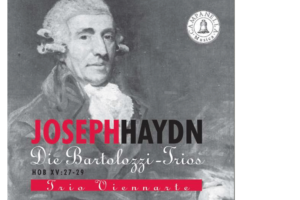It is a well-known fact that when in 1760 Haydn married Maria Anna Theresia Keller, a wigmaker’s daughter, he was not making a sensible choice. However, this obvious mistake was not able to cloud his general attitude to the fair sex, as is shown by the number of women to whom he dedicated solo and chamber works for piano. Amongst these we find Theresa Jansen, from Aachen, whose father, a very successful dancing master, had moved in 1787 to London, where his daughter, who was also a gifted composer, was receiving lessons from the highly-regarded Muzio Clementi. When in 1795 she married an art dealer, Gaetano Bartolozzi, one of the witnesses at the ceremony was Haydn, who was staying in the capital at the time.
It is irrelevant whether he intended the three piano trios Hob. XV 27-29 as a wedding gift or dedicated them to the young musician together with the three piano sonatas Hob. XVI 50-52 purely as a convenient opportunity; be that as it may, they demand a high degree of pianistic skill, and their charm and playful grace show that Haydn, despite the fact that her name bore a certain similarity to that of his wife, who had remained in Vienna, had not left the straight and narrow when composing these most beguiling pieces.
Tracklisting
Joseph Haydn (1732-1809)
Klaviertrio C-Dur Hob XV: 27
01 Allegro
02 Andante
03 Finale. Presto
Klaviertrio E-Dur Hob XV: 28
04 Allegro moderato
05 Allegretto
06 Finale. Allegro
Klaviertrio Es-Dur Hob XV: 29
07 Poco Allegro
08 Andantino et innocentemente
09 Finale im deutschen Stil: Presto assai
TT 50:12
Artists
Trio Viennarte
Veronika Schulz, Violin
Julia Schreyvogel, Cello
Maria Rom, Piano
Reviews
☞ »Die oft harschen, kühlen Akzente, die steilen Crescendi, das kernige Spiel in allen Instrumenten passen perfekt zum heiteren, wenn auch nicht harmlosen späten Haydn. Ansonsten kann man sich diese Meisterwerke ausgefeilter, durchdachter, vor allem aber temperamentvoller gespielt kaum vorstellen.« M. B. Weiß in KLASSIK heute 5 / 2001
☞ »Es ist verständlich, dass Haydns Klaviertrios weniger bekannt sind als seine Sinfonien und Streichquartette, aber es gibt hier viel feine Musik zu genießen und kein Gefühl, dass es sich um unbedeutende Produkte aus der Werkstatt des Meisters handelt. Es handelt sich in der Tat um reife Werke, die um 1795 entstanden sind …« MusicWeb International,


